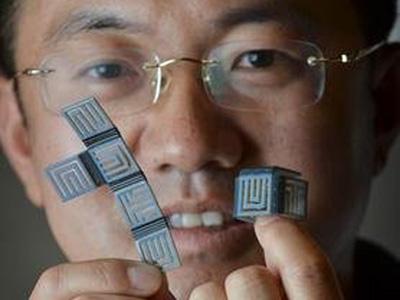4D: There has been so much on this topic lately. Here are a few in a group of a few first 4D printing research projects, using shape memory materials. There are many more, but all originate from these below. There are essentially 2 sources, the original ones to label "4D", MIT and 10 months later, University of Colorado.
Get the latest 4D Printing from 4D Printing Magazine.
For related resources, Design for Disassembly, Eco-Design, Environment and AD Technology guidelines related to this can be downloaded for free at:
______________________________________________________________________________
MIT's 4D printing tech makes objects assemble themselves
Thursday, February 28, 2013 - 3:04pm
| |||||||
| |||||||
The following's original post can be found here in 'Product Design and Development':
4D Printing Technology for Composite Materials
Tue, 10/22/2013 - 1:48pm
Researchers at the University of Colorado Boulder have successfully added a fourth dimension to their printing technology, opening up exciting possibilities for the creation and use of adaptive, composite materials in manufacturing, packaging, and biomedical applications.
A team led by H. Jerry Qi, associate professor of mechanical engineering at CU-Boulder, and his collaborator Martin L. Dunn of the Singapore University of Technology and Design has developed and tested a method for 4D printing. The researchers incorporated "shape memory" polymer fibers into the composite materials used in traditional 3D printing, which results in the production of an object fixed in one shape that can later be changed to take on a new shape.
"In this work, the initial configuration is created by 3D printing, and then the programmed action of the shape memory fibers creates time dependence of the configuration – the 4D aspect," said Dunn, a former CU-Boulder mechanical engineering faculty member who has studied the mechanics and physics of composite materials for more two decades.
The 4D printing concept, which allows materials to "self-assemble" into 3D structures, was initially proposed by Massachusetts Institute of Technology faculty member Skylar Tibbits in April of this year. Tibbits and his team combined a strand of plastic with a layer made out of "smart" material that could self-assemble in water.
"We advanced this concept by creating composite materials that can morph into several different, complicated shapes based on a different physical mechanism," said Dunn. "The secret of using shape memory polymer fibers to generate desired shape changes of the composite material is how the architecture of the fibers is designed, including their location, orientation and other factors."
The CU-Boulder team's findings were published last month in the journal Applied Physics Letters. The paper was co-authored by Qi "Kevin" Ge, who joined MIT as a postdoctoral research associate in September.
"The fascinating thing is that these shapes are defined during the design stage, which was not achievable a few years ago," said Qi.
The CU-Boulder team demonstrated that the orientation and location of the fibers within the composite determines the degree of shape memory effects like folding, curling, stretching or twisting. The researchers also showed the ability to control those effects by heating or cooling the composite material.
Qi says 3D printing technology, which has existed for about three decades, has only recently advanced to the point that active fibers can be incorporated into the composites so their behavior can be predictably controlled when the object is subjected to thermal and mechanical forces.
The technology promises exciting new possibilities for a variety of applications. Qi said that a solar panel or similar product could be produced in a flat configuration onto which functional devices can be easily installed. It could then be changed to a compact shape for packing and shipping. After arriving at its destination, the product could be activated to form a different shape that optimizes its function.
As 3D printing technology matures with more printable materials and higher resolution at larger scales, the research should help provide a new approach to creating reversible or tunable 3D surfaces and solids in engineering like the composite shells of complex shapes used in automobiles, aircraft and antennas.
______________________________________________________________________________
The following's original post can be found here in 'Design News':
Materials & Assembly
4D Printing Self-Assembled Shapes Using Shape Memory Plastics
Last spring we told you about MIT's Skylar Tibbits, whose TED talk made the idea of 4D printing famous. The process self-assembles a 3D-printed object underwater using Stratasys's materials and its Objet Connex 500 Multi Materialsinkjet 3D printer.
Researchers at the University of Colorado Boulder have combined 3D printing on the Objet Connex multi-material 3D printer with making shape-memory composites, calling that process 4D printing. By incorporating shape memory polymer fibers into a matrix of the 3D printer's composite multi-materials, an object can be printed in one shape and change its shape later, such as self-assembling into a cube. The team, led by associate professor of mechanical engineering H. Jerry Qi, detail their work in an open-access article published in Applied Physics Letters. Other authors are postdoctoral research associate Qi Kevin Ge, and Martin L. Dunn, a professor at the Singapore University of Technology and Design.

Researchers led by H. Jerry Qi at the University of Colorado Boulder have combined Objet Connex multi-material 3D printing with making shape-memory composites, calling that process 4D printing. An object can be printed in one shape, such as the flat piece (left), and change its shape later, such as self-assembling into a cube (right) by applying heat.
(Source: Glenn Asakawa/University of Colorado Boulder)
(Source: Glenn Asakawa/University of Colorado Boulder)
In the article, the team describes how they designed and printed flat laminate materials that can be thermomechanically programmed to form a variety of complex, three-dimensional shapes, such as twisted, coiled, and bent strips of material, or sheets that fold themselves into cubes or various curves. When the material is heated again, these assembled shapes can then be returned to flat sheets.
The team calls its new materials design printed active composites. The specific shapes and their behavior, such as folding, curling, twisting, and stretching, are determined by the architecture of the fibers and how they are designed, such as their shape, size, location, and orientation in the matrix. This architecture is specified within a CAD file and the composite is 3D printed directly from that file.
The researchers emphasizes that their materials are different from Tibbits' in part because theirs are soft: the glassy polymer fibers are embedded in an elastomeric matrix. But they also say that "one can extend the concept to general spatial variations of materials properties and use computational design tool such as shape and topology optimization to design the layout of the materials in the composite, as well as exploit instabilities to create large configurational changes."
An example application for the technology includes a flat solar panel that could change itself into a more compact shape for shipping, and then revert back after it's received. The Air Force Office of Scientific Research and the National Science Foundation provided funding for the research.
____________________________________________________________________________
For related resources, Design for Disassembly, Eco-Design, Environment and AD Technology guidelines related to this can be downloaded for free at:



No comments:
Post a Comment